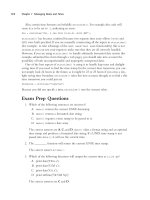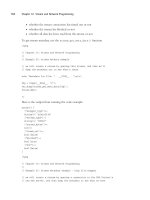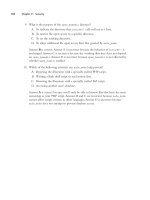Zend PHP Certification Study Guide- P9
Bạn đang xem bản rút gọn của tài liệu. Xem và tải ngay bản đầy đủ của tài liệu tại đây (136.54 KB, 20 trang )
09 7090 ch08 7/16/04 8:45 AM Page 144
Please purchase PDF Split-Merge on www.verypdf.com to remove this watermark.
9
PHP and Databases
P
HP
IS USED TOGETHER WITH A DATABASE SERVER
(DBMS) of some kind, and the
platform (of which the DBMS is part) is usually referred to by an acronym that
incorporates a particular brand of database—for example, LAMP stands for
Linux/Apache/MySQL/PHP.
When it comes to the certification program, however, you are not required to know
how any DBMS in particular works.This is because, in a real-world scenario, you might
find yourself in a situation in which any number of different DBMSs could be used.
Because the goal of the certification program is to test your proficiency in PHP—and
not in a particular DBMS—you will find yourself facing questions that deal with the
best practices that a PHP developer should, in general, know about database program-
ming.
This doesn’t mean that you shouldn’t expect technical, to-the-point questions—they
will just be less based on actual PHP code than on concepts and general knowledge.You
should, nonetheless, expect questions that deal with the basic aspects of the SQL lan-
guage in a way that is DBMS agnostic—and, if you’re used to a particular DBMS, this
might present a bit of a problem because the SQL language is quite limited in its nature
and each specific DBMS uses its own dialect that is often not compatible with other
database systems.
As a result, if you are familiar with databases, you will find this chapter somewhat lim-
ited in its explanation of database concepts and techniques because we are somewhat
constrained by the rules set in place by the certification process. However, you can find a
very large number of excellent resources on creating good databases and managing them,
both dedicated to a specific DBMS and to general techniques. Our goal in this chapter is
to provide you with the basic elements that you are likely to find in your exam.
10 7090 ch09 7/16/04 8:42 AM Page 145
Please purchase PDF Split-Merge on www.verypdf.com to remove this watermark.
146
Chapter 9 PHP and Databases
Terms You’ll Need to Understand
n
Database
n
Tabl e
n
Column
n
Key
n
Index
n
Primary key
n
Foreign key
n
Referential Integrity
n
Sorting
n
Grouping
n
Aggregate functions
n
Transaction
n
Escaping
Techniques You’ll Need to Master
n
Creating tables
n
Designing and optimizing indices
n
Inserting and deleting data
n
Selecting data from tables
n
Sorting resultsets
n
Grouping and aggregating data
n
Using transactions
n
Escaping user input
n
Managing dates
“Databasics”
Most modern general-purpose DBMSs belong to a family known as “relational databas-
es.” In a relational DBMS, the information is organized in schemas (or databases), which,
in turn contain zero or more tables. A table, as its name implies, is a container of rows (or
records)—each one of which is composed of one or more columns (or fields).
Generally speaking, each column in a table has a data type—for example, integer or
floating-point number, variable-length character string (VARCHAR), fixed-length char-
acter string (CHAR), and so on. Although they are not part of the SQL-92 standard,
10 7090 ch09 7/16/04 8:42 AM Page 146
Please purchase PDF Split-Merge on www.verypdf.com to remove this watermark.
147
“Databasics”
many databases define other data types that can come in very handy, such as large text
strings, binary strings, and sets.You can expect pretty much every DBMS to implement
the same basic types, so most of the time you won’t have much of a problem porting
data from one to the other as needed.
Indices
Databases are really good at organizing data, but they need to be instructed as to how the
data is going to be accessed.
Imagine a situation in which you have a table that contains a million telephone num-
bers and you want to retrieve a particular one. Because the database doesn’t normally
know how you’re going to access the data, its only choice will be to start at the begin-
ning of the table and read every row until it finds the one you requested.
Even for a fast computer, this could be a very costly proposition in terms of perform-
ance, particularly if the telephone number you’re looking for is at the end of the list.
To solve this problem, database systems introduce the concept of “index.” Just like the
index on your telephone directory, indices in a database table enable the server to opti-
mize the data stored in the table so that it can be retrieved quickly and efficiently.
Writing Good Indices
As you can imagine, good indexing is possibly one of most crucial aspects of a fast and
efficient database. No matter how fast your database server is, poor indexing will always
undermine your performance.What’s worse, you won’t notice that your indices are not
working properly until enough data is in a table to make an impact on your server’s
capability to retrieve information quickly in a sequential way, so you might end up hav-
ing bottlenecks that are not easy to solve in a situation in which there is a lot of pressure
on you to solve them rapidly.
In an ideal situation, you will be working side-by-side with a database administrator
(DBA), who will know the ins and outs of your server and help you optimize your
indices in a way that best covers your needs. However, even without a DBA on hand,
there are a few rules that should help you create better indices:
n
Whenever you write a query that accesses data, try to ensure that your table’s
indices are going to be able to satisfy your selection criteria. For example, if your
search is limited by the contents of columns A, B, and C, all three of them should
be part of a single index for maximum performance.
n
Don’t assume that a query is optimized just because it runs quickly. In reality, it
might be fast only because there is a small amount of data and, even though no
indices are being used, the database server can go through the existing information
without noticeable performance deterioration.
n
Do your homework. Most DMBSs provide a set of tools that can be used to mon-
itor the server’s activity.These often include the ability to view how each query is
being optimized by the server. Spotting potential performance issues is easy when
the DBMS itself is telling you that it can’t find an index that satisfies your needs!
10 7090 ch09 7/16/04 8:42 AM Page 147
Please purchase PDF Split-Merge on www.verypdf.com to remove this watermark.
148
Chapter 9 PHP and Databases
Primary Keys
The columns that are part of an index are called keys.A special type of index uses a key
known as a “primary key.”The primary key is a designated column (or a set of columns)
inside a table whose values must always respect these constraints:
n
The value assigned to the key column (or columns) in any one row must not be
NULL.
n
The value assigned to the key column (or columns) in any one row must be com-
pletely unique within the table.
Primary keys are extremely important whenever you need to uniquely identify a partic-
ular row through a single set of columns. Because the database server automatically
enforces the uniqueness of the information inserted in a primary key, you can take
advantage of this fact to ensure that you don’t have any duplicates in your database.
For example, if the user “John Smith” tries to create an account in your system, you can
designate the user’s name as the primary key of a table to ensure that he can’t create
more than one account because the DBMS won’t let you create two records with the
same key.
In some database systems, the primary key also dictates the way in which records are
arranged physically by the data storage mechanism that the DBMS used. However, this
does not necessarily mean that a primary key is more efficient than any other properly
designed index—it simply serves a different purpose.
Foreign Keys and Relations
A staple of relational databases is the concept of “foreign key.” A foreign key is a column
in a table that references a column in another table. For example, if you have a table with
all the phone numbers and names of your clients, and another table with their addresses,
you can add a column to the second table called “phone number” and make it a foreign
key to the phone number in the first table.This will cause the database server to only
accept telephone numbers for insertion in the second table if they also appear in the first
one.
Foreign keys are extremely important because they can be used to enforce referential
integrity—that is, the assurance that the information between tables that are related to
each other is self-consistent. In the preceding example, by making the phone number in
the second table a foreign key to the first, you ensure that the second table will never
contain an address for a client whose telephone number doesn’t exist in the first.
Even though the SQL standard does require the ability to define and use foreign keys,
not all popular DBMSs actually implement them. Notably, MySQL versions up to 5.0
have no support for this feature.
Even if your database system doesn’t support relational integrity, you can still support
it within your applications—in fact, you will have to anyway because you will have to
advise your users appropriately when they make a mistake that would cause duplicate or
orphaned records to be created.
10 7090 ch09 7/16/04 8:42 AM Page 148
Please purchase PDF Split-Merge on www.verypdf.com to remove this watermark.
149
Creating Tables or Adding and Removing Rows
Creating Tables or Adding and Removing Rows
Although the exact details of the syntax used to create a new table varies significantly
from one DBMS to another, this operation is always performed by using the
CREATE
TABLE
statement, which usually takes this form:
CREATE TABLE table_name
(
Column1 datatype[,
Column2 datatype[,
...]]
)
It’s important to note that a table must have at least one field because its existence would
be completely meaningless otherwise. Most database systems also implement limits on
the length of each field’s name, as well as the number of fields that can be stored in any
given table (remember that this limit can be circumvented, at least to a certain degree, by
creating multiple tables and referencing them using foreign keys).
Inserting a Row
The
INSERT
statement is used to insert a new row inside a table:
INSERT [INTO] table_name
[(column1[, column2[, column]])]
VALUES
(value1[, value2[, valuen]])
As you can see, you can specify a list of columns in which you are actually placing data,
followed by the keyword
VALUES
and then by a list of the values you want to use. Any
column that you don’t specify in your insertion list is automatically initialized by the
DBMS according to the rules you defined when you created the table. If you don’t spec-
ify a list of columns, on the other hand, you will have to provide a value for each col-
umn in the table.
Deleting Rows
The
DELETE
statement is used to remove one or more rows from a table. In its most basic
form, it only needs to know where the data is being deleted from:
DELETE [FROM] table_name
This command deleted all the rows from a particular table. Normally, this is not some-
thing that you will actually want to do during the course of your day-to-day opera-
tions—almost all the time, you will want to have a finer degree of control over what is
deleted.
10 7090 ch09 7/16/04 8:42 AM Page 149
Please purchase PDF Split-Merge on www.verypdf.com to remove this watermark.
150
Chapter 9 PHP and Databases
This can be accomplished by specifying a
WHERE
clause together with your
DELETE
statement. For example,
DELETE FROM my_table
WHERE user_name = ‘Daniel’
This will cause all the rows of
my_table
, in which the value of the
user_name
column is
‘Daniel’
, to be deleted. Naturally, a
FROM
clause can contain a wide-ranging number of
different expressions you can use to determine which information is deleted from a table
with a very fine level of detail—but those go beyond the scope of this chapter. Although
a few basic conditions are common to most database systems, a vast number of these
implement their own custom extensions to the
WHERE
syntax.
Retrieving Information from a Database
The basic tool for retrieving information from a database is the
SELECT
statement:
Select *
From my_table
This is perhaps the most basic type of data selection that you can perform. It extracts all
the values for all the columns from the table called
my_table
.The asterisk indicates that
we want the data from all the columns, whereas the
FROM
clause indicates which table we
want to extract the data from.
Extracting all the columns from a table is, generally speaking, not advisable—even if
you need to use all of them in your scripts.This is because by using the wildcard opera-
tor, you are betting on the fact that the structure of the database will never change—
someone could remove one of the columns from the table and you would never find out
because this query would still work.
A better approach consists of explicitly requesting that a particular set of values be
returned:
Select column_a, column_b
From my_table
As you can see, you can specify a list of columns by separating them with a comma. Just
as with the
DELETE
statement, you can narrow down the number of rows returned by
using a
WHERE
clause. For example,
Select column_a, column_b
From my_table
Where column_a > 10 and column_b <> ‘Daniel’
Extracting Data from More Than One Table
One of the most useful aspects of database development is the fact that you can spread
your data across multiple tables and then retrieve the information from any combination
of them at the same time using a process known as joining.
10 7090 ch09 7/16/04 8:42 AM Page 150
Please purchase PDF Split-Merge on www.verypdf.com to remove this watermark.
151
Aggregate Functions
When joining multiple tables together, it is important to establish how they are relat-
ed to each other so that the database system can determine how to organize the data in
the proper way.
The most common type of join is called an inner join. It works by returning the rows
from two tables in which a common key expression is satisfied by both tables. Here’s an
example:
Select *
From table1 inner join table2 on table1.id = table2.id
When executing this query, the database will look at the
table1.id = table2.id
con-
dition and only return those rows from both tables where it is satisfied.You might think
that by changing the condition to
table1.id <> table2.id
, you could find all the
rows that appear in one table but not the other. In fact, this causes the DBMS to actually
go through each row of the first table and extract all the rows from the second table
where the
id
column doesn’t have the same value, and then do so for the second row,
and so forth—and you’ll end up with a resultset that contains every row in both tables
many times over.
You can, on the other hand, select all the rows from one of the two tables and only
those of the other that match a given condition using an outer join. For example,
Select *
From table1 left outer join table2 on table1.id = table2.id
This will cause the database system to retrieve all the rows from
table1
and only those
from
table2
where the
id
column has the same value as its counterpart in
table1
.You
could also use
RIGHT OUTER JOIN
to take all the rows from
table2
and only those from
table1
that have the
id
column in common.
Because join clauses can be nested, you can create a query that selects data from an
arbitrary number of tables, although some database systems will still impose a limitation
on the number of columns that you can retrieve.
Aggregate Functions
The rows of a resultset can be grouped by an arbitrary set of rows so that aggregate data
can be determined on their values.
The grouping is performed by specifying a
GROUP BY
clause in your query:
SELECT *
From my_table
Group by column_a
This results in the information extracted from the table to be grouped according to the
value of
column_a
—all the rows in which the column has the same value will be placed
next to each other in the resultset.
10 7090 ch09 7/16/04 8:42 AM Page 151
Please purchase PDF Split-Merge on www.verypdf.com to remove this watermark.









